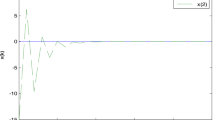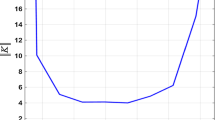Abstract
In this paper, an adaptive sliding mode control incorporating with a nonlinear disturbance observer is proposed for a class of second-order nonlinear systems with unknown parameters and matched lumped disturbance. A double hyperbolic reaching law with chattering-free characteristic is first constructed, and an adaptive sliding mode controller is designed to guarantee the satisfactory tracking performance and fast error convergence. The chattering problem is eliminated by means of the infinitely approaching equilibrium point instead of crossing it by employing two hyperbolic functions. In order to identify the unknown parameters accurately, an adaptive parametric update law is presented through constructing a set of auxiliary filtered variables. Then, a nonlinear disturbance observer is proposed to improve the tracking performance and compensate for the lumped disturbance including perturbations and uncertainties. The stability analysis is provided by the Lyapunov stability theory, and a numerical simulation on a mass-spring damper system is given to demonstrate the effectiveness of the proposed method.
Similar content being viewed by others
References
W. Perruquetti and J. P. Barbot, Sliding Mode Control in Engineering, Marcel Dekker Inc, New York, 2002.
C. Edwards and S. K. Spurgeon, Sliding Mode Control: Theory and Applications, Taylor and Francis Ltd, London, 1998.
Y. Wang, L. Gu, Y. Xu, and X. Cao, “Practical tracking control of robot manipulators with continuous fractionalorder nonsingular terminal sliding mode,” IEEE Transactions on Industrial Electronics, vol. 63, no. 10, pp. 6194–6204, October 2016.
S. Ding, W. X. Zheng, J. Sun, and J. Wang, “Second–order sliding mode controller design and its implementation for buck converters,” IEEE Transactions on Industrial Informatics, vol. 14, no. 5, pp. 1990–2000, May 2018.
S. Ding, L. Liu, and W. X. Zheng, “Sliding mode direct yaw–moment control design for in–wheel electric vehicles,” IEEE Transactions on Industrial Electronics, vol. 64, no. 8, pp. 6752–6762, August 2017.
J. H. Song, S. M. Song, and H. B. Zhou, “Adaptive nonsingular fast terminal sliding mode guidance law with impact angle constraints,” International Journal of Control, Automation and Systems, vol. 14, no. 1, pp. 99–114, February 2016.
Q. Chen, S. Z. Xie, M. X. Sun, and X. X. He, “Adaptive non–singular fixed–time attitude stabilization of uncertain spacecraft,” IEEE Transactions on Aerospace and Electronic Systems, pp. 1–13, May 2018. DOI: 10.1109/TAES.2018.2832998
G. Bartolini, A. Ferrara, E. Usai, and V. I. Utkin, “On multi–input chattering free second–order sliding mode control,” IEEE Transactions on Automatic Control, vol. 45, no. 9, pp. 1711–1717, September 2000.
S. Yu, X. Yu, B. Shirinzadeh, and Z. Man, “Continuous finite–time control for robotic manipulators with terminal sliding mode,” Automatica, vol. 41, no. 11, pp. 1957–1964, November 2005.
Q. Chen, X. Ren, J. Na, and D. Zheng, “Adaptive robust finite–time neural control of uncertain pmsm servo system with nonlinear dead zone,” Neural Computing and Applications, vol. 28, no. 12, pp. 3725–3736, December 2017.
Y. Pan, C. Yang, L. Pan, and H. Yu, “Integral sliding mode control: Performance, modification and improvement,” IEEE Transactions on Industrial Informatics, vol. 14, no. 7, pp. 3087–3096, July 2018.
A. Levant and B. Shustin, “Quasi–continuous mimo sliding–mode control,” IEEE Transactions on Automatic Control, vol. 63, no. 9, pp. 3068–3074, September 2018.
J. Baek, M. Jin, and S. Han, “A new adaptive slidingmode control scheme for application to robot manipulators,” IEEE Transactions on Industrial Electronics, vol. 63, no. 6, pp. 3628–3637, June 2016.
W. Gao, Theory and Design Method for Variable Sliding Mode Control, Science Press, Beijing, 1996.
W. Gao and J. C. Hung, “Variable structure control of nonlinear systems: A new approach,” IEEE Transactions on Industrial Electronics, vol. 40, no. 1, pp. 45–55, February 1993.
C. J. Fallaha, M. Saad, H. Y. Kanaan, and K. Al–Haddad, “Sliding–mode robot control with exponential reaching law,” IEEE Transactions on Industrial Electronics, vol. 58, no. 2, pp. 600–610, February 2011.
S. M. Mozayan, M. Saad, H. Vahedi, H. Fortin–Blanchette, and M. Soltani, “Sliding mode control of pmsg wind turbine based on enhanced exponential reaching law,” IEEE Transactions on Industrial Electronics, vol. 63, no. 10, pp. 6148–6159, October 2016.
X. Lu and S. K. Spurgeon, “Output feedback stabilization of mimo nonlinear systems via dynamic sliding mode,” International Journal of Control, vol. 9, no. 5, pp. 275–305, April 2015.
X. Lu and S. K. Spurgeon, “Robust sliding mode control of uncertain nonlinear systems,” Systems & control letters, vol. 32, no. 2, pp. 75–90, November 1997.
M. Asad, A. I. Bhatti, and S. Iqbal, “A novel reaching law for smooth sliding mode control using inverse hyperbolic function,” Proc. of International Conference on Emerging Technologies, pp. 65–70, 2012.
Y. Zhou, Y. C. Soh, and J. X. Shen, “Speed estimation and nonmatched time–varying parameter identification for a dc motor with hybrid sliding–mode observer,” IEEE Transactions on Industrial Electronics, vol. 60, no. 12, pp. 5539–5549, December 2013.
J. Na, M. N. Mahyuddin, G. Herrmann, X. Ren, and P. Barber, “Robust adaptive finite time parameter estimation and control for robotic systems,” International Journal of Robust & Nonlinear Control, vol. 25, no. 16, pp. 3045–3071, November 2015.
J. Na, Y. Huang, X. Xu, G. Gao, G. Herrmann, and J. Z. Jiang, “Active adaptive estimation and control for vehicle suspensions with prescribed performance,” IEEE Transactions on Control Systems Technology, vol.26, no. 6, pp. 2063–2077, November 2018.
H. Ríos, D. Efimov, J. A. Moreno, W. Perruquetti, and J. G. Rueda–Escobedo, “Time–varying parameter identification algorithms: Finite and fixed–time convergence,” IEEE Transactions on Automatic Control, vol. 62, no. 7, pp. 3671–3678, July 2017.
F. Guo, H. Kodamana, Y. Zhao, B. Huang, and Y. Ding, “Robust identification of nonlinear errors–in–variables systems with parameter uncertainties using variational bayesian approach,” IEEE Transactions on Industrial Informatics, vol. 13, no. 6, pp. 3047–3057, December 2017.
Q. Chen, L. Tao, Y. Nan, and X. Ren, “Adaptive nonlinear sliding mode control of mechanical servo system with Lu–Gre friction compensation,” Journal of Dynamic Systems, Measurement and Control, vol. 138, no. 2, pp. 021003–1–9, February 2016.
C. Afri, V. Andrieu, L. Bako, and P. Dufour, “State and parameter estimation: a nonlinear luenberger observer approach,” IEEE Transactions on Automatic Control, vol. 62, no. 2, pp. 973–980, February 2017.
X. H. Bu and Z. S Hou, “Adaptive iterative learning control for linear systems with binary–valued observations,” IEEE Transactions on Neural Networks and Learning Systems, vol. 29, no. 1, pp. 232–237, January 2018.
Z. H. Liu, H. L. Wei, Q. C. Zhang, K. Liu, X.–S. Xiao, and L.–H. Wu, “Parameter estimation for vsi–fed pmsm based on a dynamic pso with learning strategies,” IEEE Transactions on Power Electronics, vol. 32, no. 4, pp. 3154–3165, April 2017.
Y. Mao, F. Ding, and Y. Liu, “Parameter estimation algorithms for Hammerstein time–delay systems based on the orthogonal matching pursuit scheme,” IET Signal Processing, vol. 11, no. 3, pp. 265–274, May 2017.
B. Kurkcu, C. Kasnakoglu, and M. O. Efe, “Disturbance/ uncertainty estimator based integral sliding mode control,” IEEE Transactions on Automatic Control, vol.63, no.11, pp. 3940–3947, November 2018.
J. Yang, S. Li, and X. Yu, “Sliding–mode control for systems with mismatched uncertainties via a disturbance observer,” IEEE Transactions on Industrial Electronics, vol. 60, no. 1, pp. 160–169, January 2013.
A. Kawamura, H. Itoh, and K. Sakamoto, “Chattering reduction of disturbance observer based sliding mode control,” IEEE Transactions on Industry Applications, vol. 30, no. 2, pp. 456–461, March 1994.
H. S. Kang, Y. Lee, C. H. Hyun, H. Lee, and M. Park, “Design of sliding–mode control based on fuzzy disturbance observer for minimization of switching gain and chattering,” Soft Computing, vol. 19, no. 4, pp. 851–858, April 2015.
W. H. Chen, J. Yang, L. Guo, and S. Li, “Disturbanceobserver–based control and related methods–an overview,” IEEE Transactions on Industrial Electronics, vol. 63, no. 2, pp. 1083–1095, February 2016.
S. Li, J. Wei, K. Guo, and W. Zhu, “Nonlinear robust prediction control of hybrid active–passive heave compensator with extended disturbance observer,” IEEE Transactions on Industrial Electronics, vol. 64, no. 8, pp. 6684–6694, August 2017.
L. Zhou, Z. Che, and C. Yang, “Disturbance observerbased integral sliding mode control for singularly perturbed systems with mismatched disturbances,” IEEE Transactions on Industrial Electronics, vol. 6, pp. 9854–9861, February 2018.
B. Xu, F. Sun, Y. Pan, and B. Chen, “Disturbance observer based composite learning fuzzy control of nonlinear systems with unknown dead zone,” IEEE Transactions on Systems, Man, and Cybernetics: Systems, vol. 47, no. 8, pp. 1854–1862, August 2017.
B. Xu, “Composite learning control of flexible–link manipulator using NN and DOB,” IEEE Transactions on Systems, Man, and Cybernetics: Systems, vol. 48, no. 11, pp. 1979–1985, November 2018.
C. C. Fuh and H. H. Tsai, “Adaptive parameter identification of servo control systems with noise and highfrequency uncertainties,” Mechanical Systems & Signal Processing, vol. 21, no. 3, pp. 1437–1451, April 2007.
J. T. Huang, “Sufficient conditions for parameter convergence in linearizable systems,” IEEE Transactions on Automatic Control, vol. 48, no. 5, pp. 878–880, May 2003.
G. Y. Lai, C. Y. Wen, Z. Liu, Y. Zhang, C. L. P. Chen, and S. L. Xie, “Adaptive compensation for infinite number of actuator failures based on tuning function approach,” Automatica, vol. 87, pp. 365–374, January 2018.
L. Tao, Q. Chen, Y. R. Nan, C. Wu, “Double hyperbolic reaching law with chattering–free and fast convergence,” IEEE Access, vol. 6, pp. 27717–27725, May 2018.
L. Yang and J. Y. Yang, “Nonsingular fast terminal slidingmode control for nonlinear dynamical systems,” International Journal of Robust & Nonlinear Control, vol. 21, no. 16, pp. 1865–1879, November 2011.
J. Wang, S. S. Ge, and T. H. Lee, Adaptive Control of Nonsmooth Dynamic Systems, Springer, London, pp. 211–248, 2001.
Author information
Authors and Affiliations
Corresponding author
Additional information
Recommended by Associate Editor Hongyi Li under the direction of Editor Hamid Reza Karimi. This work was supported by the National Natural Science Foundation of China under Grant No. 61403343, and Zhejiang Provincial Natural Science Foundation under Grant No. LY17F030018.
Liang Tao received the B.Eng. degree in electronic information engineering from Anhui Agricultural University, Hefei, China, in 2011. He is currently pursuing a Ph.D. degree with the College of Information Engineering, Zhejiang University of Technology, Hangzhou, China. From 2011 to 2013, he was with Flextronics (Suzhou) Company Ltd., and Daxi Electronic Instrument (Kunshan) Company Ltd., as a Research and Development Assistant Engineer and an Electrical Design Engineer, respectively. His research interests include servo system control, sliding mode control, and parameter identification.
Qiang Chen received the B.S. degree in measurement and control technology and instrumentation from Hebei Agricultural University, Baoding, China, in 2006 and the Ph.D. degree in control science and engineering from Beijing Institute of Technology, Beijing, China, in 2012. He is currently an associate professor with the College of Information Engineering, Zhejiang University of Technology, Hangzhou, China. His research interests include neural networks, sliding mode control and adaptive learning control with applications to motion control systems.
Yurong Nan received the B.Eng. degree in industrial automation and the M.Eng. degree in electrical drive and automation from Tianjin University, Tianjin, China, in 1987 and 1990, respectively, and the Ph.D. degree in control theory and control engineering from Zhejiang University of Technology, Hangzhou, China, in 2008. He has worked with Zhejiang University of Technology since 1990. He is currently a Professor of the College of Information Engineering, Zhejiang University of Technology. His research interests include power electronics, electrical drive and automation and embedded systems.
Rights and permissions
About this article
Cite this article
Tao, L., Chen, Q. & Nan, Y. Disturbance-observer Based Adaptive Control for Second-order Nonlinear Systems Using Chattering-free Reaching Law. Int. J. Control Autom. Syst. 17, 356–369 (2019). https://doi.org/10.1007/s12555-018-0277-5
Received:
Revised:
Accepted:
Published:
Issue Date:
DOI: https://doi.org/10.1007/s12555-018-0277-5




